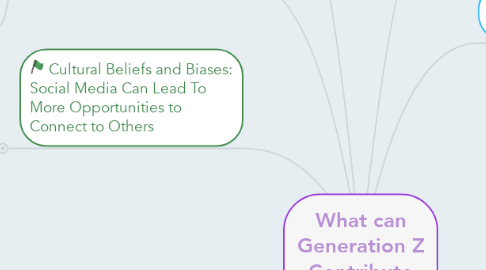What can Generation Z Contribute to society?
by Tahira Jackson

1. Existing Social Condition: Technology
1.1. Generation Z is impacting the use, development, and improvement of technology
1.2. The advancement in technology becomes a characteristic of this generation. The ever-growing technological world has never stopped during the rise of this generation. They have become accustom to “upgrades” always readily available of the market to a new protégé being released within months or a year after the release of their, now, expired device
2. Existing Social Condition: Communication
2.1. Generation Z is changing the ways of communication.
2.2. This generation is all about connecting with others, and not only with people either. During the rise of this generation, the world has opened their minds to connecting with other devices – called syncing. Since birth, members of Generation Z have always known that a response is always just a click away. They are also the first generation inherent in the interconnected web, with the possibility to obtain and stay connected to everything.
3. Social Role: Adolescents
3.1. Generation Z is the cohorde of adolescents that are inhabiting the Earth today.
3.2. They are born from 1995-2012.
3.3. They are the offspring of Generation Y.
3.4. Adolescents are have under development brains which are susceptible to damage. SEE BRAIN DEVELOPMENT
3.5. Immaturity = lack in experience, intelligence, and integrity
4. Social Role: "The Future"
4.1. Simply put, Generation Z is "the future."
4.2. They are the future engineers, doctors, lawyers, presidents, managers, biologists, economists, mothers, fathers, misfits, deviants, and so on.
4.3. The future of society is dependent on their generation. Their generation has also caused significant changes in the present society.
5. Cultural Beliefs and Biases: Social Media Can Lead To More Opportunities to Connect to Others
5.1. Social media has became a way of life for Generation Z.
5.2. The influence of social media is not all negative. In some cases social media has been used to promote rights such as to end sexual harassment and bullying, and to defend the rights of the LGBT community.
5.3. They believe that social media can provide broader possibilities for communication even if it may induce the opposite effect.
5.4. With the growing need for online communication, it has enabled the possibility for people from opposite ends of the city, state, or even the world to connect with each other in ways that were not possible nearly 20 years ago.
5.5. The use of social media has taken authenticity and empathy out of person-to-person communication and human contact.
6. Cultural Beliefs and Biases: Advancements in Technology Can Give Access to More Resources
6.1. The use of technology has become essential to everyday life.
6.2. Technology is used to carry out the most simpliest of tasks such as in setting up an alarm on a phone to wake up in the morning, using a Fitbit watch to count the steps taken throughout the day, and using Pinterest to look up the recipe to the next meal that's for dinner.
6.3. Cell phones and internet were not possible before 1973, and computers did not make their debut into the average modern American home until 1981 (Woodford, 2015).
6.4. The technology that they have influenced so far is streaming media and data, HDTV, wireless internet, MP3 players, electronic books, touchscreens, self-cleaning robots, and advanced computers (Woodford, 2015).
6.5. The options are limitless.
7. Social Inequalities: Brain Development
7.1. One aspect that is overlooked is the brain development of Generation Z. This is all in theory, of course, unless we dissect each individual. But it has been proven that the increased amount of screen time can lead to decreased brain size in the frontal lobe which is responsible for "planning, prioritizing, organizing, and impulse control." (Dunckley, 2014)
7.2. As explained by Lin & Zhou et al (2012), Addiction to screen time can cause structural and functional alterations in the brain areas that are associated with emotional processing, focusing, decision-making, and thinking ability (Dunckley, 2014)
7.3. Dunckley (2014) also mentions atrophy to the white matter which is responsible for the communication throughout the brain.
7.4. Dunckley (2014) also notes that brain atrophy is also present in the striatum which controls the morals of socially unacceptable impulses - which can result in the stupid and dangerous acts Generation Z is so willing to carry out for social acceptance. "Do it for the Vine."
7.5. Increased screen time can also lead to diminished cognitive function. Studies have found poor information processing, diminished impulse control, heightened responsiveness to rewards, and dull affection to loss. (Dong & Devito, 2013)
7.6. Generation Z is the first generation of the digital age. With that, this generation has spend more of their lives behind a screen that any other generation before them. With increased screen time it can lead to poor social skills, increased vision concerns, increased aggression, and a 52% of possibly dying early in relation to the changes of brain development. (Thorpe, 2015) (Green, 2015)
8. Social Inequalities: Those Who Can Not Afford
8.1. In 2010, 77% of Americans had a computer in their homes (Economic & Statistics Administration, 2011).
8.2. As Smith (2012) mentioned, the access to computers, internet, and technology in general may be the difference in-between a lower class household versus a middle class to upper class household. With the use of technology, comes access to information; valuable information such as job seeking resources and high education opportunities. Popular places like Walmart and Target, which are a part of almost 80% of the Fortune 500 Companies, only accept job applications online (Smith, 2012). Smith (2012) also quoted from a 2008 study conducted by the Federal Reserve that high school students that have access to the internet have 6% to 8% higher in graduation rates compared to their counterparts.
8.3. The adolescents that do not have access to technology or the internet are at far more of a disadvantage then those who do have access.


